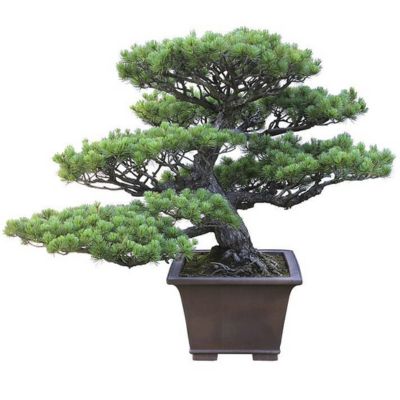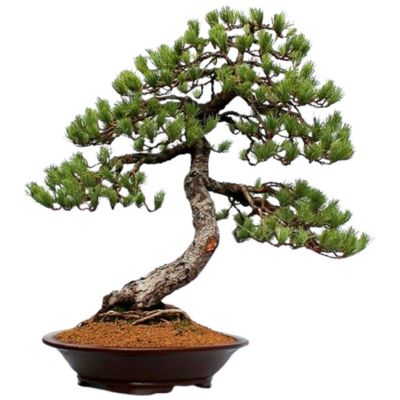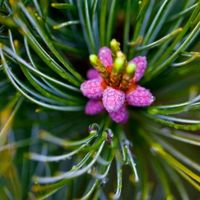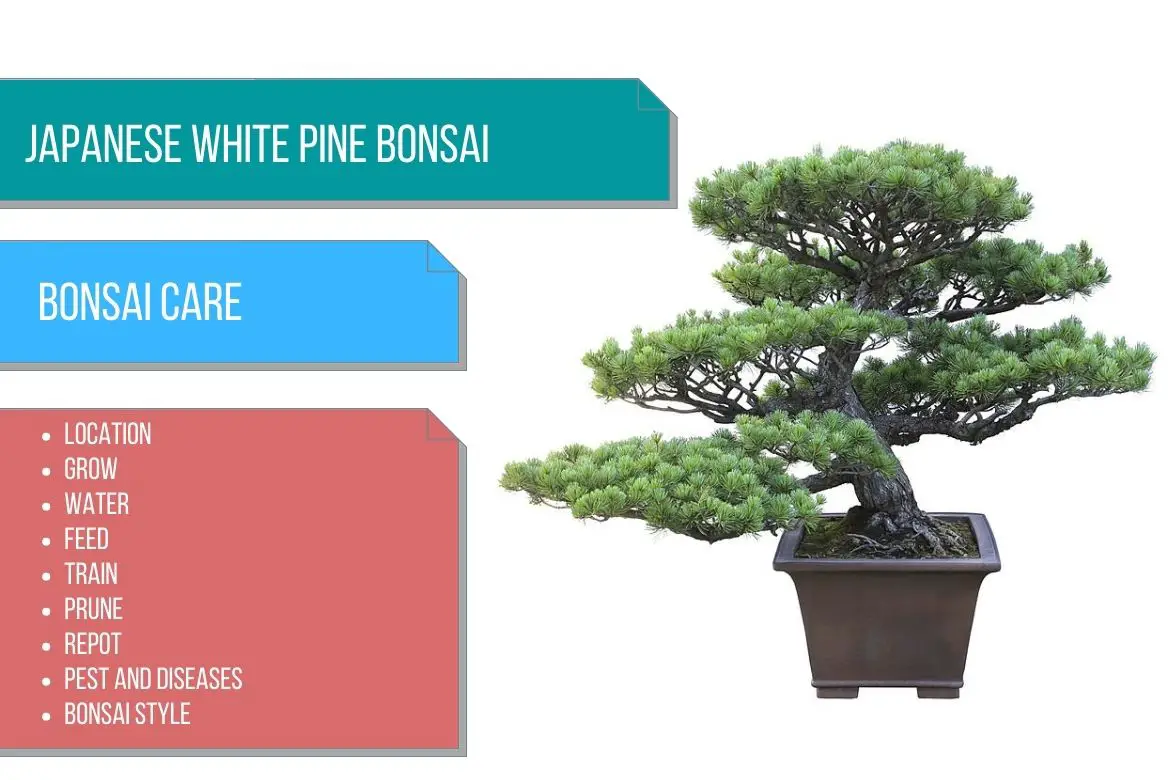
Japanese white pine
(Pinus parviflora)
Country of Origin : Japan
Bonsai Styles : Informal or formal upright, slanting, semi-cascade, or cascade.
Zone : 6 – 9
An evergreen tree, Japanese white pine tree is the most graceful and dainty of all pines.
Japanese white pine bonsai is one of the classic bonsai. White pine bonsai can live for a long time.
These trees are sometimes also called Japanese five-needled pines, because of the soft needles grow in groups of five.
Young white pine trees have smooth grayish black bark. The bark starts developing small plates as the tree matures.
White pine trees are grafter on the rootstock of more sturdy and hardy Japanese black pine tree (Pinus thunbergii). Because of this, the bark of white pine tree develops deep fissures pretty soon (usually these fissures come when the white pine tree is pretty old).
Note: They are usually less vigorous and slightly yellow-tinged when grown on their own roots.
The conical shape of this medium-sized young white bonsai tree changes to an irregular shape with a flat top, as it matures.
It produces clusters of small flowers in spring. The botanical name of Japanese white pine tree – Pinus parviflora – literally translates to “small- flowered pine”. Upon fertilization, the flowers lead to dark-brown cones, which may hang on the tree for years.
Many bonsai growers prefer pines, and Japanese black and white pines are among the most popular pine varieties.
Note : The care and maintenance of both black and white pine bonsai trees are pretty much the same (pruning and selection techniques may vary a little).
Some of the common Japanese white pine cultivators are:
- Pinus parviflora ‘Miyajima’ – This is a dwarf variety of Japanese white pine tree. These varieties are perfect for growing on rocks bonsai style.
- Pinus parviflora ‘Kokonoe’ – This is also a dwarf variety of Japanese white pine tree. The needles on this white pine bonsai tree variety are small in size and grow very close to each other. This structure is perfect for making a small bonsai. It takes couple of years for the foliage to become dense.


There are five needles per group, and they are green on the underside and have silvery-white lines along the center of the other two sides. These lines give the impression that the tree is surrounded by a blue haze.

Read more about other bonsai trees species in : Types of bonsai tree
Best location keep Japanese white pine Bonsai
Much like Japanese black pine, white pines flourish and thrive in full sun and good air ventilation, and can only tolerate being indoors for a few days
The growth of semi-shaded white pine bonsai tree is weak and budding is poor.
In winters, protect the Japanese white pine bonsai from prolonged exposure to temperatures below 23°F (-5°C).
Also, protect the tree from cold winds and excessive rain. Continue reading outdoor bonsai tree care.
Growing white pine in Mediterranean climates is also possible. For more information on how to keep your outdoor bonsai thriving in different seasons of the year, please read seasonal care for bonsai trees.
IMP: Refer to do bonsai trees need sunlight for more indoor and outdoor bonsai location ideas.
Propagation Japanese white pine
White pine can be propagated in the winter season.
Fresh seeds should be soaked overnight. Fresh seeds ensure germination of the tree.
Discard the seeds which float and only use the seeds which sink to the bottom.
Place the seeds outside exposed to the frost. However, keep the seeds protected from birds and rodents.
Grafting of the cultivators can be done in late winter or early spring.
Watering Japanese white pine Bonsai
white pine bonsai tree is drought-resistant, but it appreciates plenty of water if the bonsai soil drains quickly.
Do not saturate the soil, but keep it moist.
For the sake of safety, it is best to shelter pines from prolonged rainfall, as they prefer very free-draining soil.
Monitor the soil daily. Water whenever the soil is dry.
Water the white pine plant sparingly in winter.
Continue reading about how to water a bonsai tree.
Wiring Japanese white pine Bonsai
Wiring young shoots of the white pine bonsai is easy as they are pretty flexible.
Wiring can be done with aluminum or copper wire.
Fall or spring season is preferred for wiring Japanese white pine bonsai.
Be sure to remove wires before they cut into the bark.
Wiring can also be done after pruning when the old dense tufts of needles are removed to expose the inner newer branches. This wiring is intended to fill the space which is created by the pruning of old needles.
Please read our detailed guide on how to wire a bonsai tree. Also, refer to our detailed bonsai tools guide and how to take proper care of your bonsai tools to know about all the tools of bonsai.
Pruning Japanese white pine Bonsai
When to prune Japanese white pine bonsai?
For a detailed guide, please read: How to prune a Japanese white pine bonsai
Pruning can be done in early fall or late summer. At this time the wounds have less chances of bleeding resin. This resin will stain the bark.
Wounds should be sealed immediately.
In mid autumn, trim the longest branches just above a clump of needles.
Make sure not to cut through any needles, otherwise they will turn brown and die.
Regularly cleaning out old needles is necessary so that light and air may penetrate into inner areas. This is because the tufts of the needles become very dense preventing light and air to go in the inner section of the tree.
If the white pine tree is not pruned properly, the lower branches of tree will start appearing week. This is because a pine tree will always focus on growing the shoots in the apex to increase height.
You can prevent this by pruning the older stronger growing branches.
Prune the most vigorous growing branches and leave 4 – 5 clusters of needles. Do less pruning on weaker branches and do not perform any pruning on the weakest branches.
This treatment should correct any imbalance in the bonsai style.
Refer to how to prune a bonsai tree for more info on best practices and tips and tricks.
Pinching Japanese white pine Bonsai
As the needles lengthen in late spring, pinch out the new candles (elongating shoots). Remove one or two of the strongest candles from a cluster of three or five.
It’s easy to pinch in the summer. Taking care not to break any needles along the way, the shoots can simply be pinched between finger and thumb as they extend.
Removing half the length of each shoot should be done on the bottom branch and finished a week or so later at the apex.
Repotting Japanese white pine Bonsai
When to repot Japanese white pine bonsai?
White pine bonsai tree can be repotted every 2 to 5 years in spring. Younger plants every 2 years, while older plants every 5 years. This also depends on the root development.
When untangling the roots, take care not to tear them.
You’re in luck if you notice fluffy white stuff around the roots. The fungus aids in the digestion of nutrients by the tree.
Mix 30 percent organic matter with 70 percent grit.
OR
Use akadama with 30% grit.
OR
Mix of sharp sand and Akadama soil in 50:50 ratio.
You can read how to repot a bonsai tree to know more about the best guidelines to follow while repotting.
Also, continue reading about how to make bonsai soil at home and how to choose a pot for your bonsai.
Feeding Japanese white pine Bonsai
During the spring and summer, apply a balanced fertilizer. In the fall and early winter, use a low-nitrogen or nitrogen-free fertilizer.
OR
Half-strength solution of balanced feed applied throughout summer, one nitrogen-free feed applied in fall, plus slow-release organic fertilizer applied in mid winter.
Plants should not be overfed or the needles will grow long and the branches will thicken.
During the growing season, you can also apply small amounts of rapeseed fertilizer.
Continue reading about bonsai fertilizer and its application.
Diseases and pest of Japanese white pine Bonsai
If the soil remains wet for too long, white pines are susceptible to root rot.
You can prevent this problem by ensuring that the soil is extremely free-draining and sheltering the tree from prolonged rainfall, especially during the winter.
Sap-rich shoots and needles attract woolly aphids, mealy bugs, adelgids, and other undesirables.
Mix a drop of detergent with a systemic insecticide in water. Apply this to get rid of these pests. The detergent will help in penetrating the waxy coating on insect’s body.
Adelgids on new shoots can become problematic if left unattended. Use an insecticide to control the insects.
Refer the in-depth guide for bonsai pest and diseases identification and treatment for more details.
Also, read best practices to keep your bonsai pest free.
Japanese white pine bonsai care
Overwatering is probably the biggest risk. Be careful whole watering.
You should be especially cautious during the winter months. Though fully hardy, the roots may suffer if frozen for an extended period.
Avoid exposure to drying cold winds.
You can remove the cones produced from the flowers so that the plant does not spends its energy in setting seeds. Also, the cones can ruin the look of the bonsai ( as the large cones do not match with the small size of the white pine bonsai tree).
On older wood, white pines are unlikely to produce adventitious buds, without which new branches cannot form. It is essential to feed, pull needles, and pinch shoots regularly.
In autumn, Japanese white pines shed their old needles, which can be alarming, but you can simply pick them off with your fingers. You will soon see the tree looking beautiful again.
What to look for when buying Japanese white pine tree Bonsai
Ensure that the graft union is reasonably unobtrusive and hidden behind a thoughtfully positioned branch.
White pine trees which are grown from seeds will have smooth bark. White pines grafted onto black pine roots will develop a trunk with deep fissures.
Some prefer the smooth texture of the bark which adds to the feminine look of the white pine bonsai tree. However, some consider the smooth texture as boring and lacking in character.
Which one to choose totally depends on your artistic outlook.
However, remember that the white pine which has grown from seed will be slow to develop.
Ensure that the graft union is well hidden behind the foliage.

